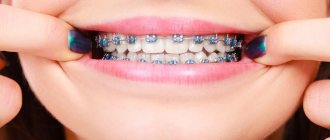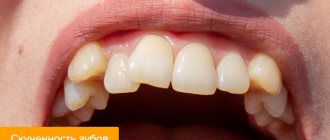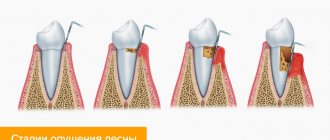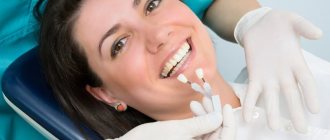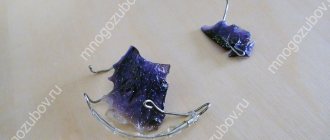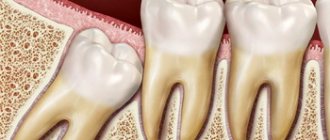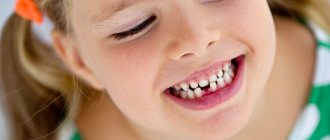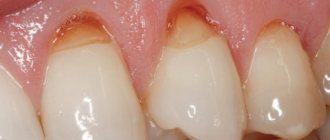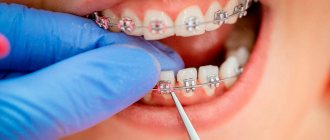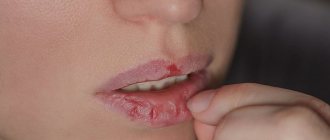Bite pathologies are one of the most common reasons for visiting a dentist. People have been engaged in returning teeth “to their place” since ancient times - there is evidence that this issue was of interest in ancient Egypt. However, only in recent decades have doctors come to the conclusion that it is necessary to correct an abnormal bite. Timely orthodontic treatment helps to avoid serious consequences for the entire body in the future. In this article, the leading orthodontist at the ZUUB dental clinic on Lipetskaya in Moscow, Dmitry Anatolyevich Polovkov, talks about the dangers of malocclusion and ways to correct it.
Correct bite - what is it?
Normal, or physiological occlusion, is characterized by the absence of disturbances in the arrangement of the dentition relative to each other with the jaws fully closed. He can be:
- regular, or orthognathic - in this case, the upper teeth overlap the lower teeth by a third of their height and there are no pronounced gaps between the dentition;
- straight - both jaws clearly close;
- biprognathic - both the upper and lower dentition are slightly tilted forward;
- progenic - only the lower jaw is pushed forward a little, but this does not prevent the cutting edges of the teeth from completely closing.
Correct bite is the absence of pronounced gaps between the teeth when the upper teeth are in contact with the lower ones opposite them. Orthodontists determine a bite without pathologies based on the following characteristics.
- The upper front teeth overlap the lower ones by 1/3 of their height.
- The incisors and canines are arranged in an even, arched line without distortions or crevices.
- The upper teeth protrude slightly outward, the lower teeth “look” slightly inward.
- All teeth are clearly below each other.
- The center of the jaws vertically coincides with the midline of the face, there are no protruding parts of the cheekbones or chin.
It is important to remember that in order to form a correct bite, you need to be careful about teething and caring for them.
Which braces system should you choose?
The least expensive and most proven option is metal braces. Plastic ones are also inexpensive, but they are inferior in strength to metal ones. If aesthetics are more important to you, opt for more expensive ceramic, sapphire or lingual braces.
As for “internal” braces, their only difference from all others is the aesthetic factor. One of the inconveniences is that such braces change the diction, they are more difficult to care for and they are not suitable for everyone. You need to have an almost perfect bite: just “uneven teeth.”
Causes of malocclusion
Malocclusion (malocclusion) is due to various reasons: congenital or acquired. An important role is played by genetic factors, as well as insufficient intake of calcium into the mother’s body when carrying a child. Hereditary problems with bite require certain nuances in treatment. Therefore, before carrying out any orthodontic manipulations, the doctor talks with the parents and learns about all the possible factors in the occurrence of pathology.
Acquired malocclusion develops gradually. It appears at different ages due to its own reasons.
In childhood
- Bad habits (finger sucking, pacifiers, chewing on objects).
- Being on artificial feeding.
- Pathological bone formation.
- Teeth grinding (bruxism).
- Lack of sufficient solid food in the child's diet.
- Mouth breathing (formed as a habit or due to respiratory diseases).
- The replacement of baby teeth occurs too sooner or later.
- Pathologies associated with metabolism.
- Calcium and fluoride deficiency.
- Pronounced carious lesion.
- Injuries of the maxillofacial apparatus
In adults
- Installation of unsuitable dentures.
- Diastemas that form as a result of tooth extraction.
- Various types of injuries.
- Lack of space for eights (wisdom teeth).
- Unusual localization of the language.
- Diseases of the musculoskeletal system.
How to prevent malocclusion in adulthood
If you are lucky and by the age of 18–20 you have a completely normal bite, this can be maintained until old age. To do this, you need to follow the following recommendations:
- Visit the dentist every six months to a year. He recognizes malocclusion at an early stage, and also notices in time any diseases that can lead to tooth loss and malocclusion.
- Treat any diseases of the teeth and gums in a timely manner. Untreated caries or gingivitis can ultimately easily lead to tooth loss, and therefore to malocclusion.
- Find out in advance about the condition of your wisdom teeth. If the eights have not yet erupted, you should go to the doctor and get an x-ray to see if they are growing sideways or putting pressure on neighboring teeth. It may be better to remove these teeth. If they begin to erupt, you should also consult a dentist to understand whether eruption is proceeding normally.
- Avoid jaw injuries. Protect your face while playing dangerous and contact sports.
- Eat solid foods more often: vegetables and fruits. This keeps teeth in “working” condition and helps keep them healthy longer.
- Do not bite hard objects with your teeth or open bottles. Because of this, teeth can easily break off and become destroyed.
- If a tooth is lost, a prosthesis should be installed immediately to prevent other teeth from moving into the resulting space.
Types of malocclusion in adults and children
Dentists usually divide anomalous occlusions into planes.
- Sagittal - characterized by elongated/shortened rows of teeth.
- Transversal - narrowed/expanded dentition is visible.
- Vertical - the presence of shortened/elongated certain areas in the dentition.
In addition, in dental practice it is customary to use the following classification of occlusion.
- Distal.
Sagittal occlusion with the upper jaw pushed forward. - Mesial.
Also a sagittal variety, but with the lower jaw moving forward. - Cross.
Transversal pathology with displacement of the jaws, which can only be partially formed, in one direction or another. - Open.
Vertical occlusion occurs with both partial and complete non-occlusion of teeth. - Deep.
The so-called traumatic, contributing to damage to the enamel. Characteristic is almost maximum overlap of the lower rows with the upper ones. - Vertical occlusal anomaly.
In addition to the above listed occlusion disorders, some experts identify 2 more types of anomalies:
- dystopic bite - displacement of one or more teeth;
- reducing - formed due to damaged and (or) lost teeth.
Bite correction using braces
Braces for correcting malocclusion
The most common way to correct a malocclusion in adulthood is to install braces. Braces are clasps that are attached to the teeth and connected to each other by a metal arch.
There are several types of braces with their own characteristics, advantages and disadvantages.
Metal
metal braces
Both the clasps and the bow are made of metal. Such braces are considered classic; they are most often installed because of their versatility and cost-effectiveness.
Pros:
- Suitable for any malocclusion.
- High strength.
- Low cost.
- The fastest bite correction.
Minuses:
- Lowest aesthetics - braces are too noticeable.
- Unpleasant taste and sensation in the mouth.
- They are not suitable for people with metal allergies - they have to select alloy options, often more expensive.
Ceramic
Ceramic braces
In this case, braces are made of ceramic, similar in color to tooth enamel. The arc remains metal, but is painted white.
Pros:
- Quite high aesthetics, braces are almost invisible.
- Less likely to cause irritation and allergies.
Minuses:
- They cost more than metal ones.
- More fragile, treatment takes longer.
- Not suitable for the most severe malocclusions.
Sapphire
These braces are made from artificial sapphires - they are transparent and shiny, like diamonds.
Pros:
- Aesthetic - relatively noticeable, but look like a decoration for the teeth.
Minuses:
- More expensive than metal and ceramic.
- More fragile.
Combined
Combined braces
An option in which ceramic or sapphire braces are installed on the front (usually only the upper) teeth, and metal structures on the back (and lower) teeth.
Pros:
- Quite high aesthetics - the side teeth are still not visible when smiling and talking.
- The cost is lower than braces made entirely of ceramics or sapphires.
- Copes with most malocclusions.
Minuses:
- They still cost a little more than regular metal braces.
- They are not suitable if the bite is seriously disturbed on the front teeth.
- Still uncomfortable if you have a metal allergy.
Lingual
Lingual braces
These are ordinary metal braces that are installed not in front, but in the back, on the side of the tongue.
pros:
- Complete invisibility.
- An excellent effect in correcting some malocclusions - for example, they do a good job of moving the jaw forward.
Minuses:
- The tongue is often injured and diction is impaired.
- They are more expensive than all types of braces.
- Ineffective for many malocclusions.
- Not suitable for people with metal allergies.
Plastic
These braces are made of light plastic, but they are installed very rarely due to numerous shortcomings.
Pros:
- Lowest cost.
- Relative aesthetics - for some time they are invisible on the teeth.
Minuses:
- Fragility - braces break easily and are not suitable for most malocclusions.
- Over time, the plastic absorbs food coloring and darkens, so that the braces are no longer aesthetically pleasing.
- Sometimes plastic causes allergies.
You cannot choose braces on your own; you need to do this together with your dentist. After he examines your teeth, he will make a conclusion whether you can get any other braces other than metal ones, whether lingual braces are right for you, and what type of design will be most effective in your case.
Classic metal braces cope with most malocclusions, so if the result is more important to you than aesthetics, it is better to use them.
How to correct a child's malocclusion
- Children under 7 years of age
are shown a set of gymnastic exercises and massage that will help solve the problem. - Children under 10 years of age
are already prescribed trainers, with the help of which they can set the desired direction for their teeth. They must be worn for a certain number of hours during the day. But, if the pathologies are more advanced, removable plates and mouthguards are used. Correction of the anomaly takes approximately 2 years. - For children aged 10-12
years, braces are used to correct their bite - special orthodontic structures consisting of a power arch and clasps that set an individual direction for each tooth. They cannot be placed at an earlier age; it is necessary that all milk teeth be replaced by permanent ones. How long to wear braces for malocclusion is determined by the treating orthodontist.
How to correct malocclusion in an adult
A very common treatment method for adults is wearing braces. Transparent aligners (aligners) are also very popular now. They are made of transparent plastic material. Aligners are effective in correcting impaired occlusion, are easy to use and look very aesthetically pleasing. All details about this technique can be found here.
In cases where the patient is not in the mood for long-term bite correction with aligners or braces, there is another solution - microprosthetics. In this case, special overlays are installed on the teeth - veneers, with the help of which you can correct uneven teeth and gaps between them. But if there are serious malocclusions, this technique is not used.
There are bite defects for which only surgical treatment is indicated. Examples include: severe malocclusion, facial asymmetry due to trauma or hereditary causes, and chin dysplasia.
Each method of orthodontic treatment has both indications and contraindications. Only an orthodontist can determine the method of treatment after a thorough examination and full diagnosis.
Bite in the absence of teeth
It’s interesting, but even if you have no teeth at all, there is no guarantee that with prosthetics you will be able to create the right jaw . It all depends on how damaged the dental system was before removing all its elements. If the jaws are within normal limits relative to each other, the doctor will be able to make adjustments to the prosthesis. If there are also problems with the bones, more complex methods of restoring the dentition will be necessary.
In the absence of teeth, the bite in people is determined using special wax rollers that are placed in the mouth and allow measurements to be taken. The instruments used are a ruler arc and an intraoral plate. Next, a plaster and then a regular prosthesis is created.
Consequences of malocclusion
It is a mistake to think that a pathological bite concerns only appearance and only leads to an unattractive smile. This is where the problems arise that are more serious. For example, in 90% of people with abnormal occlusion, incorrect posture is also detected. There is a logical explanation for this: with a broken bite, the center of gravity of the head shifts. This in turn affects the compensation mechanisms of the musculo-ligamentous apparatus of the maxillofacial system. The result of all this is an increase in the pathology of teeth closure.
Aesthetically, occlusion abnormalities lead to facial asymmetry. A weak-willed chin becomes pronounced, and lips protrude unattractively.
Bite after wisdom tooth removal
In modern man, wisdom teeth are an atavism, that is, an element that seems to be there, but is not required in life. They do not affect the correct closure of the teeth and do not harm the dentition in any way if they erupted correctly. This is why dentists recommend not touching wisdom teeth and not removing them unless necessary.
But if you decide to form the correct bite of your teeth as an adult, useless “eights” can serve you well. The fact is that after their removal, the dense dentition becomes freer, so that the remaining teeth can be positioned correctly.
What is the danger of malocclusion?
In addition to visual problems, more serious dysfunctions often occur, including internal organs.
- Due to increased and uneven load on the teeth, periodontal disease develops and teeth begin to decay.
- Inadequate chewing of food leads to disruption of the digestive system.
- The functioning of the temporomandibular joint is impaired.
- The respiratory system also begins to malfunction.
- Slow metabolism.
- Increased risk of developing caries, especially with cross-closing teeth.
- Problems with pronunciation of sounds.
In addition, with malocclusions, daily dental care becomes much more difficult, which contributes to the constant accumulation of plaque on them.
Make an appointment
right now!
Polovkov Dmitry Anatolievich
Orthodontist
How to care for braces?
Caring for braces requires care and discipline. We talked about it in more detail in a separate article. After installing braces, the doctor will tell you how to live now. We will indicate the most important things.
- Always have brushes and a single-tuft brush on hand.
- Add a waterpik to your arsenal.
- If you are not sure that you have brushed your teeth well, use an indicator tablet. After brushing your teeth, the tablet must be dissolved in your mouth. The areas where plaque remains will turn blue. These areas need to be cleaned again.
- Avoid very hot and very cold drinks. Braces, like enamel, do not like sudden temperature changes.
- To prevent braces from coming off, follow a diet. Eliminate nuts, toffees, seeds, and flour from your diet. Apples and other hard fruits should not be bitten off, but cut into small pieces and placed on the chewing teeth.
What to do to avoid malocclusion.
The consequences of malocclusion can be avoided by taking measures in time, namely in childhood. Here the responsibility falls largely on parents, who can promptly pay attention to problems and carry out prevention. It is important to take into account the risk of congenital disorders, hereditary predisposition, and also eliminate unfavorable factors:
- prevent the development of rickets and other diseases that impair bone growth;
- bottle feed your baby correctly;
- monitor the position of the child’s body during sleep (posture without tension, head not tilted back, etc.);
- maintain correct posture;
- timely wean your child off the pacifier, thumb sucking habit, toys and other objects;
- treat baby teeth immediately, because their early loss (as well as too late) can negatively affect the bite;
- to prevent nasal breathing disorders, namely to treat diseases of the ENT organs and ARVI.
When anomalies in the development of teeth are identified in childhood, timely assistance from an orthodontist will help solve problems faster than in advanced cases in adults. In children, as a rule, there is no need for surgical intervention yet, and even a complex of therapeutic exercises for the facial muscles can significantly help in correcting the bite.
Publisher: Expert magazine about dentistry Startsmile.ru
Types of anomalies
There can be several types of malocclusions. Let's take a closer look at them.
Deep bite
In dentistry, deep bite is considered the most common defect . Its main feature is the following: when the jaws close to each other, the upper row of teeth overlaps the lower one by a third.
In this case, there is a large load on the front teeth , and due to their contact with the oral mucosa, injury can occur. With such a defect, a violation of the aesthetics of the face occurs, that is, the lower part visually becomes shorter, the lips acquire an unattractive position.
Treatment of deep bites should begin as early as possible , since this pathology leads to loosening and loss of teeth. Ideally, treatment should begin at an early age. For this purpose, plates and braces are used, thanks to which the teeth are aligned, and thus this problem is corrected.
Open bite
An open bite is a type of anomaly in which there is a small gap between the rows of teeth. At the same time , a person with such a defect always has his mouth slightly open. As a result, he feels discomfort, since due to this problem there is always a dry mouth, the functions of digestion, speech, and breathing are disrupted.
The reasons for this anomaly can be poor heredity, jaw deformation, and bad habits at an early age , for example, thumb sucking, nail biting, as well as infectious diseases suffered by the mother during pregnancy.
Open treatment is special for each age. During the period of early treatment, myogymnastics has proven itself very well in children. In order to wean a child from bad habits, special plates with a tongue rest are used.
If treatment occurs at an older age, then various mouth guards are recommended to correct the problem. Typically, better results are achieved if treatment is started early.
Crossbite
In dentistry, there is such a type of malocclusion as crossbite. It is considered a severe disorder and can occur in both adults and children.
A distinctive feature of this pathology is the crossing of the dentition during the period when the jaws close.
There are more than enough reasons for the development of crossbite . This is both heredity and improper formation of teeth in childhood. This can also be caused by the fact that a person often develops caries.
The following forms of crossbite are distinguished:
- Buccal - represents a narrowing of the upper teeth and widening of the lower ones. This form can be either one-sided or two-sided.
- Lingual - it can also be unilateral or bilateral. Its peculiarity lies in the fact that there is an expansion of the upper dentition and a narrowing of the lower one.
- Buccal-lingual is a combination of the first and second forms.
The most unpleasant thing with such a defect is that the aesthetics of the face is impaired, and the chewing function is also impaired, which leads to problems with the gastrointestinal tract.
If such an anomaly is detected at an early age, then doctors suggest performing myogymnastics and grinding the incisors. If crossbite is detected late, patients are offered treatment using various medical devices.
Distal bite
One of the anomalies of malocclusion of teeth is distal. In this case, when the dentitions close, the upper one moves forward slightly in relation to the lower one.
The reasons for the formation of a distal appearance are varied. This can be a sore throat, breathing problems, various bad habits, and genetic predisposition can also lead to this.
This type of behavior entails disastrous consequences. Chewing and swallowing functions are impaired. There is a very high risk that caries, periodontal disease, and periodontitis may develop.
Treatment of this anomaly in children occurs with the help of dental guards and trainers, which help the development of the lower jaw, and at the same time prevent the development of the upper jaw . In adults, braces are used.
Mesial bite
A mesial bite in humans is when the lower jaw is very forward. A distinctive feature of this pathology is a forward chin , the lower teeth are located above the upper ones, which creates a concave facial profile.
There are different reasons that can cause this type of anomaly:
- trauma received by the child at birth;
- bad heredity;
- early loss of upper milk teeth;
- rickets.
Correcting this problem is a very long process , and therefore the sooner it starts, the more effective the treatment will be.
In children , when using mouth guards to correct this problem, treatment will be quick and successful . In an adult, the process lasts longer and can be carried out using braces, as well as through plastic surgery.
Reducing (acquired) bite
In dentistry, there is such a thing as a reducing, or more simply put, acquired bite. It develops during the period of permanent occlusion due to pathological abrasion of teeth, with defects in the dentition.
Such people experience pain when chewing food, facial pain, there is also decreased hearing, headaches, and when the head is tilted down, there is a rush of blood to the face.
Treatment of patients at the initial stage of this disease does not require much time and expense, the main thing is to prevent the progression of pathological tooth abrasion.
Treatment is preventative. For preliminary treatment of this anomaly, it is recommended to use a standard joint splint.
Causes of deformation
Reasons for the development of malocclusion:
- genetic factor;
- in childhood - improper attachment to the breast, bad habits in the form of finger sucking, pacifiers, too early removal or loss of milk teeth;
- inappropriate jaw and teeth sizes, for example, teeth that are too large relative to the size of the jaw;
- facial injuries or chronic diseases that provoke respiratory dysfunction;
- strong pressure from the jaw muscles, as a result of which the lower jaw shifts forward;
- deficiency of hormones produced in the thyroid gland.
Types of occlusion defects and methods of their correction
Scientists have calculated that only 40% of the planet's inhabitants are the happy owners of an ideal bite. All others have deviations from the norm to one degree or another. Defects can be critical when they have a negative impact on human health, and practically unnoticeable, not leading to moral or physical discomfort.
The picture below shows occlusion anomalies:
Modern orthodontics includes several methods for correcting malocclusion:
- using braces;
- through surgery;
- using myotherapy (physical exercises) and non-braces corrective devices.
Trainers
Orthodontic trainers are removable silicone covers for the teeth. They are worn for several hours a day: at night and for 2–4 hours during the day. They are used to correct occlusion in children and in simple situations (for example, when there are gaps between dental elements) in adults.
There are several types of trainers:
- standard for the initial stage of treatment - made of soft pink silicone. This period lasts about six months. The main goal is to influence the position of the jaws and facial muscles;
- standard for the final stage - made from harder blue silicone. They directly influence the movement of teeth in the dental row;
- Lm-activators are trainers, the unique feature of which is that they can be used before all teeth erupt, when the process is just beginning. Their use allows the teeth to settle into place immediately after eruption;
- myobraises – allow for early correction in a natural way, from the age of 3 years. The system does not work on the consequence, but on the causes of the formation of malocclusion. Myobraises are worn for 1 hour during the day and worn throughout the night.
Records
Vestibular plates are removable orthodontic devices. This means that they can be removed for a while, for example, to eat or brush your teeth. The plate for correcting pathologies is made individually for each patient using personal casts of the jaws.
The base of the plate is a plastic base that is adjacent to the palate. Arcs, clasps and screws are integrated into it. The base color can be neutral or colored.
These devices are mainly used in childhood and adolescence, when the dental system is not yet fully formed and therefore the dental elements are able to move relatively easily under the influence of directed force. The plates are also used to correct pathologies in adult patients, but only in mild cases.
Reviews about bite correction
Reviews of bite correction for adults confirm that this is not a hopeless matter - almost everyone eventually managed to achieve a perfect smile. Here are typical examples of reviews:
“I got regular metal braces to save money. I had to wear them for two whole years, then I wore the plate for another two years, but I only put it on at night, there were no problems. Now five years have passed since the treatment, my teeth are straight, everything is fine. I won’t say that there were any special problems, but I’m happy with the result.”
“To be honest, the braces themselves were terrible (Well, for me, at least. Brushing my teeth was inconvenient, in the first two weeks everything hurt. Then I got used to it, but my cheeks still sometimes scratched, I had to cover it with wax. And even though they were ceramic, people "They still noticed it around me. But I think it’s worth it - now I’ve taken off my braces and my teeth are perfectly straight! They installed a permanent retainer, but I hardly feel it, no inconvenience. So I think it was worth the patience."
“My teeth were just a little uneven, but it was annoying. I went to the dentist, and in the end they agreed on mouthguards - I can’t afford to wear braces. As a result, the treatment went unnoticed not only for those around me, but even for me - no pain, no discomfort, I can take it off and eat whatever I want, brush my teeth in peace. Remembering how I wore braces for six months as a child and comparing, I understand that in general everything went without problems. Now I wear other mouthguards to secure them, but they are still very comfortable.”
There are practically no negative reviews about bite correction. Yes, patients complain about pain and inconvenience, but in the end they are still satisfied with the result and maintain a beautiful smile for life.
